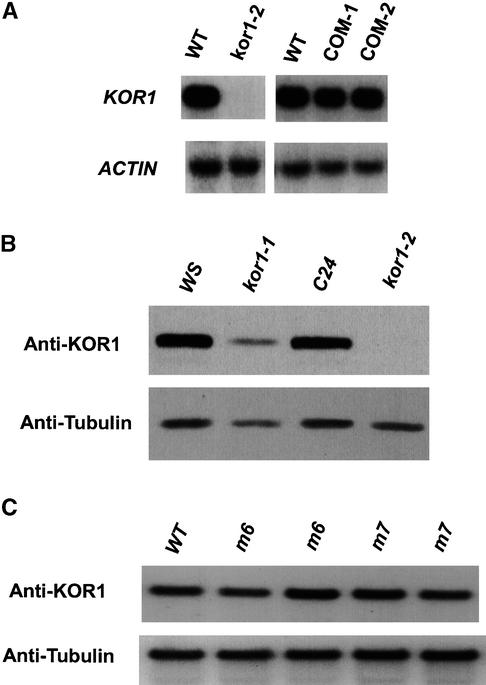Figure 4.
Expression Pattern of KOR1 in Wild-Type and kor1 Plants.
(A) RNA gel blot analysis of the KOR1 transcript. Ten micrograms of total RNA, prepared from 7-day-old seedlings, was loaded in each lane. All blots were rehybridized with an actin probe. During the first 3 weeks after germination, KOR1 expression was not detectable by RNA gel blot analysis, RT-PCR, or protein gel blot analysis (see [B]) in kor1-2 seedlings. Residual expression, however, could be detected in 4- to 5-week-old kor1-2 seedlings (data not shown), presumably the result of a cryptic promoter in the T-DNA insertion. The residual expression in kor1-2 corresponded ∼3.0 to 3.5% of that in wild-type plants at the same growth stage (assayed by quantitative RT-PCR; see Methods). COM-1 and COM-2, kor1-2 plants carrying the ORE-KOR1 or KOR1 transgenes, respectively; WT, wild type.
(B) Analysis of KOR1 proteins by protein gel blot analysis. Whole-cell extracts were prepared from 7-day-old seedlings. Approximately 20 μg of total proteins was loaded in each lane. The blot was probed with the anti-KOR1 antibody, followed by reprobing with an anti-tubulin antibody (Amersham). WS and C24, wild-type plants of the Wassilewskija and C24 ecotypes, respectively (kor1-1 and 1-2 were in WS and C24 background, respectively).
(C) Accumulation of mutant proteins in m6 and m7 seedlings. Whole-cell extracts were prepared from 3-week-old seedlings. See (B) for other technical details. WT, wild type.

